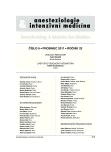Severe course of Still’s disease with multiple organ failure with predominant liver failure
Authors:
Kočan Ladislav 1; Vašková Janka 4; Vaško Ladislav 4; Hoková Hana 3; Majerník Miloš 1; Krištofová Beáta 2; Šimonová Jana 1; Firment Jozef 1
Authors‘ workplace:
I. klinika anestéziológie a intenzívnej medicíny, UN LP, Košice, SR
1; I. interná klinika, UN LP, Košice, SR
2; Klinika anestéziológie, resuscitácie a intenzívnej medicíny ÚVN SNP Ružomberok – FN, SR
3; Ústav lekárskej chémie, biochémie a klinickej biochémie, LF UPJŠ, Košice, SR
4
Published in:
Anest. intenziv. Med., 22, 2011, č. 6, s. 337-342
Category:
Intesive Care Medicine - Case Report
Overview
Still’s Disease is a disease of unknown aetiology and pathogenesis. It is characterized by fever, arthritis, salmon-coloured rash and organ failure in severe cases. This is a case report of a 31-year old female patient on long-term steroid treatment who suffered from adult Still’s disease. She was admitted to the Clinic of Anaesthesiology and Intensive Care with fever up to 40 °C, unconsciousness and signs of multi-organ failure (liver, acute kidney failure, cardiovascular system, lungs, and disseminated intravascular coagulation). A complex of examinations did not confirm the cause to be sepsis, malignancy, a haematological disease or an infectious disease (repeated blood cultures were negative). We concluded this was an acute exacerbation of adult Still’s disease complicated by the syndrome of oversize macrophage activation with secondary multi-organ failure. The patient’s condition required pulse steroid therapy, hepato-protective therapy and supplementary nutrition inclusive of parenteral selenium supplementation, antibiotics, mechanical ventilation and extra-corporeal elimination therapy. The therapy continued at the Clinic of Internal Medicine. The complex therapy resulted in great regression of the liver insufficiency. After 28 days of hospitalization the patient was discharged in an improved condition.
Key words:
Still’s disease – systemic inflammatory response syndrome – selenium – enteral nutrition – parenteral nutrition – glutathione peroxidase
Sources
1. Bywaters, E. G. L. Still´s disease in the adult. Ann. Rheum. Dis., 1971, 30, p. 121–132.
2. Keher, J. P. Free radicals as mediators of tissue injury and disease. Critical rev. Toxicol., 1993, 23, p. 21–48.
3. Geoghegan, M., Mcauley, D., Eaton, S., Powel-Tuck, J. Selenium in critical illness. Critical Care, 2006, 12, p. 136–141.
4. Kočan, L., Firment, J., Šimonová, J., Vašková, J., Guzy, J. Suplementácia selénu u pacientov s ťažkou akútnou pankreatitídou. Rozhl. v Chirurgii, 2010, 89, 1, p. 518–521.
5. Gartner, R., Albrich, W., Angustwurm, M. W. The effect of selenium supplementation on the outcome of patients with severe systemic inflammation, burn and trauma. Biofactors, 2001, 14, p. 199–204.
6. Imlay, J. Pathways of oxidative damage. Annual Review of Microbiology, 2003, 57, p. 395–418.
7. Andrews, P. J. Selenium and glutamine supplements: where are we heading? A critical care perspective. Current Opinion in Clinical Nutrition and Metabolic Care, 2010, 13, p. 192–197.
8. Zadák, Z. Umělá výživa při poškození jater. In Zadák, Z. Výživa v intenzivní péči. Grada Publishing a.s. : Praha, 2008, p. 359–365, ISBN: 978-80-247-2844-5.
9. Turecký, L. Poškodenie pečene voľnými radikálmi. In Ďuračková, Z. Voľné radikály a antioxidanty v medicíne II. Slovac Academic Press s.r.o. 1999, p. 210-218,ISBN: 80-88908-46-9.
10. Berger, M., Chiolero, R. Antioxidant supplementation in sepsis and systematic inflammatory response syndrome. Critical Care Medicine, 2007, 35 p. 584–590.
11. Forceville, X. Seleno-enzymes and seleno-compounds: the two faces of selenium. Critical Care, 2006, 10, p. 180.
12. Muller, F. L., Lustgarten, M. S., Jang, Y., Richardson, A., Van Remmen, H. Trends in oxidative aging theories. Free Radic. Biol. Med., 2007, 43, p. 477–503.
13. Záhorec, R. Pomer neutrofilov a lymfocytov – rýchly a jednoduchý ukazovateľ systémového zápalu a stresu u pacientov v kritických stavoch. Bratislavské Lekárske Listy, 2001, 102, p. 5–14.
Labels
Anaesthesiology, Resuscitation and Inten Intensive Care MedicineArticle was published in
Anaesthesiology and Intensive Care Medicine

2011 Issue 6
Most read in this issue
- Principles of mechanical ventilation in chronic obstructive pulmonary disease
- Severe course of Still’s disease with multiple organ failure with predominant liver failure
- The fascial plane concept
- To cool or not to cool? Obstacles to implementing therapeutic hypothermia guidelines
